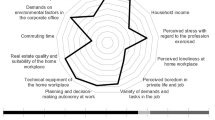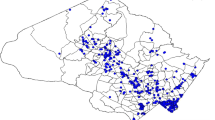Conclusion
It must be concluded that in spite of an interest in home-ownership expressed by interviewees in an earlier study (Market Research Africa 1986), the approach to home-ownership and stabilisation of its work-force undertaken by the Anglo American Corporation has not satisfied the housing needs and aspirations of the majority of employees interviewed in this study. This fundamental inadequacy calls for a new perspective in employer home-ownership schemes which incorporates the hitherto unforeseen or unacknowledged diversity of housing requirements, while progressively reducing the legacy of dependency on the employer. As pressures for democratisation and worker participation in the industry are likely to increase in the 1990s, the planner will be in an important position to effect appropriate changes, and to respond to the needs and aspirations of the population.
Similar content being viewed by others
References
Anglo American Corporation. 1988. Housing and Accommodation Practices on Anglo American Gold Mines in South Africa: Status Report. Gold and Uranium Division, July.
Boaden, B.G.B. 1981. Alternative approaches to the housing of black mineworkers: A case study.Industrial Relations Journal of South Africa 1 (4), 1–14.
Friedmann, J. 1978. Innovation, Flexible Response and Social Learning: A Problem in the Theory of Meta-Planning. In Burchell, R.W. and Sternlieb, G. (eds),Planning Theory in the 1980s: A Search for Future Directions. Rutgers, NJ, Centre for Urban Policy Research, pp. 163–177.
James, W.G. 1988. Urban labour and the gold mining industry.Industrial Relations Journal of South Africa 8 (4), 15–30.
James, W.G. 1989. ‘The Group with the Flag’: Mine Hostels as Contested Institutions. African Studies Institute Seminar Paper No. 247, University of the Witwatersrand.
Johnstone, F.A. 1976.Class, Race and Gold: A Study of Class Relations and Racial Discrimination in South Africa. London, Routledge and Kegan Paul.
Lipton, M. 1980. Men of two worlds: Migrant labour in South Africa.Optima 29 (2/3).
Market Research Africa. 1986. Accommodation Study, Target Group Report No. 1.
McNamara, J.K. 1986. The Degree of Interest in Home Ownership Near the Place of Work among Black Mine Employees. Unpublished Report prepared for the Chamber of Mines Research Organisation.
Mezger, D. 1979. How the mining industry undermines liberation movements in Southern Africa.Journal of Southern African Affairs 4 (3).
Morris, P.M.R. 1981.A History of Black Housing in South Africa. Johannesburg, South Africa Foundation.
Motlatsi, J. 1987. 1987 — The Year Mineworkers Take Control. Presidential Address, National Union of Mineworkers Congress.South African Labour Bulletin 12 (37), 39–49.
Peart, C.M. 1986. The Urbanisation of Part of the Black Migrant Mine Labour Force: A Preliminary Investigation. Unpublished Consultancy Report prepared for the Chamber of Mines Research Organisation.
Perlman, J.E. 1987. Misconceptions about the urban poor and the dynamics of housing policy evolution.Journal of Planning Education and Research 6 (3), 187–196.
Stahl, C.W. 1981. Migrant Labour Supplies, Past, Present and Future, with special reference to the Gold Mining Industry. In Bohning, W.R. (ed.),Black Migration to South Africa. Geneva, International Labour Organization.
Susskind, L. and Elliott, M. 1983. Paternalism, Conflict and Co-production: Learning from Citizen Actions and Citizen Participation in Western Europe. New York, Plenum Press.
Turner, J.F.C. 1968. Housing priorities, settlement patterns and urban development in modernising countries.American Institute of Planning Journal Nov., 353–363.
— 1972. Housing as a Verb. In Turner, J.F.C. and Fichter, R. (eds),Freedom to Build. New York, Macmillan, pp. 148–176.
Wilson, F. 1972.Labour in the South African Gold Mines 1911–1969. Cambridge, Cambridge University Press.
Rights and permissions
About this article
Cite this article
Laburn-Peart, C. Home-ownership schemes for black mineworkers: overestimating and underplanning. Urban Forum 1, 69–82 (1990). https://doi.org/10.1007/BF03036574
Issue Date:
DOI: https://doi.org/10.1007/BF03036574




